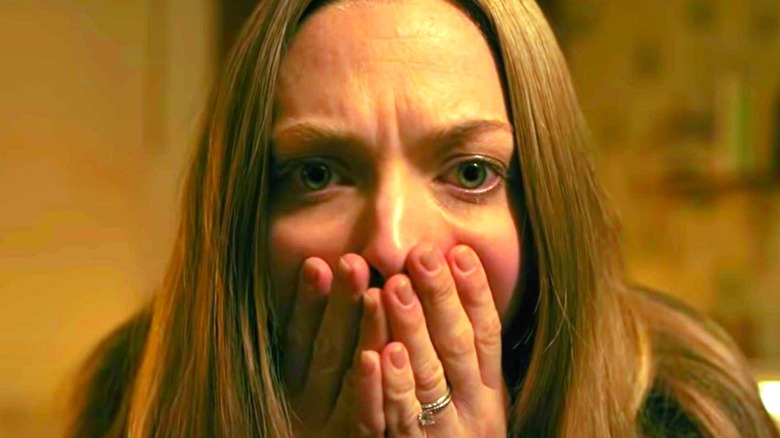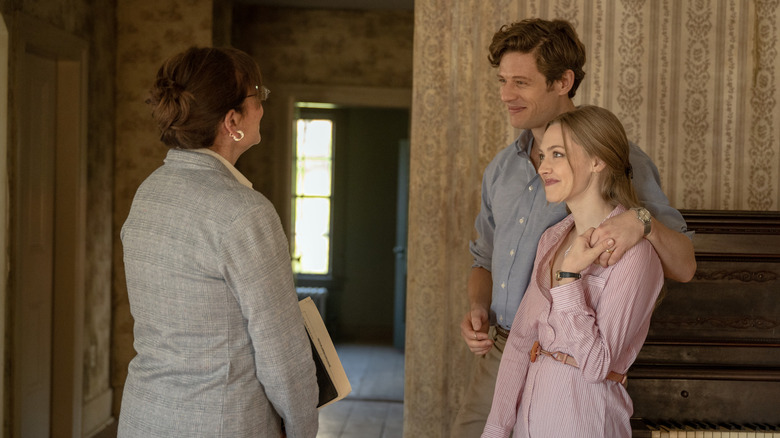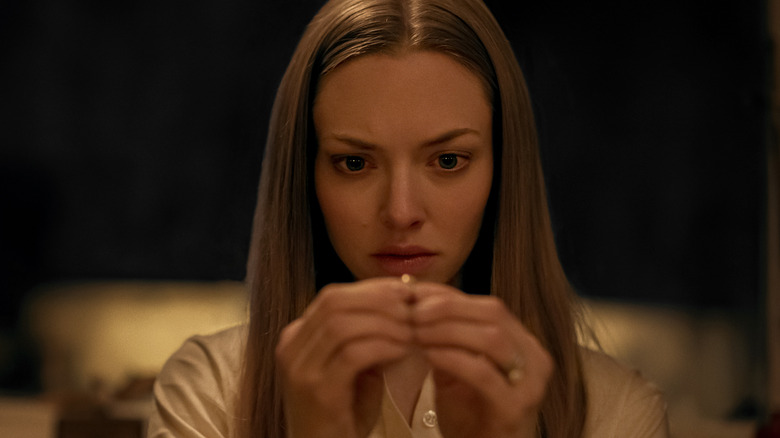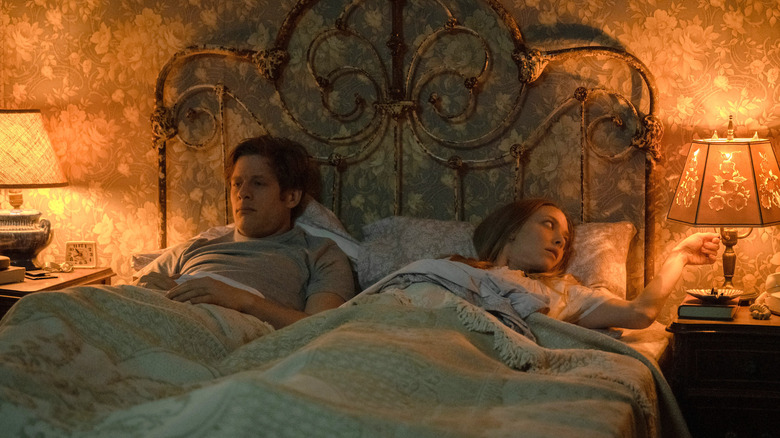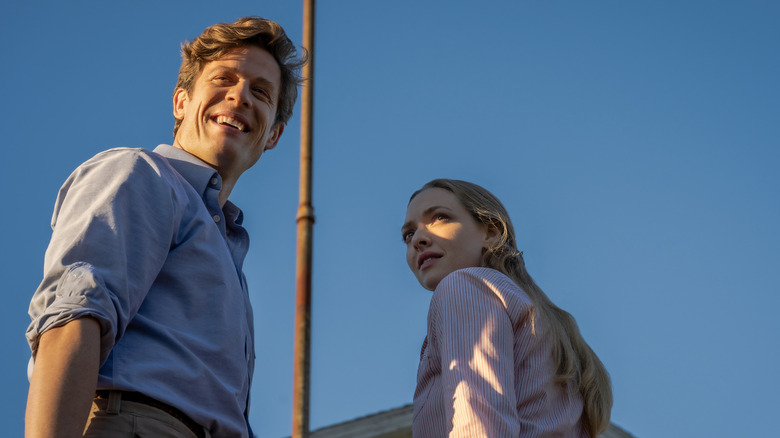The Biggest Differences Between Netflix's Things Heard & Seen And The Book
Netflix has slowly become known for very effective horror films over the years. Whether it's the Spanish sci-fi horror flick "The Platform," or the Stephen King adaptation of "Gerald's Game," there are a lot of great horror stories on offer on the streaming network, and there's another new one just added that's worth checking out.
Released on April 29, 2021, the new film called "Things Heard & Seen" stars Amanda Seyfried ("Mank") and James Norton ("Little Women") as Catherine and George Clare, a young couple that moves to an old farmhouse in Upstate NY when George gets a new job as an art professor. Previously an art restorer, Catherine is delegated to being a stay-at-home mom to their young daughter, Franny (Ana Sophia Heger), and she has trouble adjusting to the new, quiet life. But soon enough that's not the only challenge she has, as strange, ghostly occurrences start happening in the house. At the same time, George starts unraveling, revealing to Catherine that she might not really know the man she married.
"Things Heard & Seen" is based on a book called "All Things Cease to Appear" by Elizabeth Brundage, a bestseller inspired by the author's own history spent living in Upstate NY. While the film's story mostly stays true to the book, there are obviously a few differences between the two mediums.
Here are the biggest differences between the new film "Things Heard & Seen" and the book it's based on.
Spoilers ahead for both the movie "Things Heard & Seen" and the book "All Things Cease to Appear."
Things Heard & Seen has a different setting and doesn't time jump
One of the most distinct features of the book is how it rotates through different characters' perspectives, even that of Willis, played by Natalia Dyer in the movie, the young woman George has an affair with. The directors of the film, Shari Springer Berman and Robert Pulcini, spoke with Decider about their movie, explaining the changes in the film adaptation, saying, "we made it purely from Catherine's perspective, as opposed to being from multiple perspectives. And we shrunk the amount of time that the whole story took place over."
Unlike the movie, the book tells the full story of Ella Hale (Vayle in the film) and her demise, showing life at the farm for Eddie, Cole, and their family before their parents died. Forced to compress the story to fit the film's runtime, the movie doesn't explicitly show what happened to Ella, instead allowing Catherine and the audience to find out from others in town. Also a notable difference, "Things Heard & Seen" moves the story from the 1970s to the 1980s, just slightly modernizing everything to make it feel more relatable and understandable for audiences.
The movie goes deeper with ghosts and the supernatural
Both the book and the movie explore the cyclical nature of relationships with abusive, toxic men controlling, and in many cases murdering, their wives. In the book, it's very clear that the reason the crimes repeat themselves is because of the human actions of the characters, while the movie questions more about whether George is fully in control of his actions, or if he's poisoned by the spirits of the new house.
While both the book and the movie incorporate ghosts and the idea that the farmhouse might be cursed, the movie relies more heavily on these ideas. After Catherine and George move into the new home with Franny, they start experiencing strange ongoings. At one point the bedroom smells like car exhaust (an echo of Ella and her husband's death), lights flicker, the radio plays while not plugged in, and other weird things happen. But it gets more intense for Catherine after she finds an old ring in the kitchen that used to belong to Ella. When Catherine puts it on, she appears to feel a direct connection with the spirits in the house. Along with that, Catherine finds a book in the movie cataloging the inhabitants of the house over the past couple hundred years. There's clearly a history of bad things happening, with a few people even crossed off the record and labelled "Damned." Ella's ghost also has a more prominent presence in the film, even making a few solid appearances at the end.
Overall, the novel has small occurrences like this throughout, creating a creepy, ill-fated tone, but the effect the ghosts and the house have on Catherine and George is more felt than seen.
The film shows the murder of Catherine
One of the biggest questions in the book is whether or not George really murders his wife Catherine. The book starts with the day after the murder, when George arrives home from work to supposedly discover his wife murdered in her bed. By the end of the book, it's pretty obvious that George is at fault, but nothing comes of it until 30 years later, when new evidence emerges. The author, Brundage, was influenced by a cold case from Rochester, New York from 1982, when Cathleen Krauseneck was found in her bed murdered by an axe, with her 3-year-old daughter elsewhere in the house. Thankfully, after almost 40 years, the husband was arrested in late 2019 and is currently awaiting trial (via Democrat & Chronicle).
Considering this influence, the guilt on George's part is pretty clear, but part of the point of the book is that there isn't enough evidence, both for the police in the story and the reader, to convict him. Purposely, the book doesn't include a scene of the actual murder, so it's hard to know for sure what happened. In the movie, the audience sees George murder Catherine and then stage the crime scene. At first, it seems like he might get away with all of his crimes, but then Justine wakes up and intends to tell the police the truth. George attempts to run away, but in the end his crimes catch up to him, and he's pulled down to Hell, literally.
There's no epilogue and a very different, symbolic ending
The final scenes of "Things Heard & Seen" and "All Things Cease to Appear" are quite similar at first glance. In the film, George flees and gets on a sailboat called "Lost Horizon" in the middle of a storm, and he quickly gets caught up in the wind and waves. George attempts to steer the sailboat, but in the end he is drawn into a hole that opens up in the water and looks like a portal to Hell. In a way, George gets his comeuppance, falling in as the voices of Ella and Catherine call him "damned" for his crimes.
In the book, George actually gets away with his crimes for some time. After Catherine's murder, the novel has an epilogue set 30 years in the future, when Franny is all grown up and in the third year of her surgical residency. She gets a call about the farmhouse being sold and returns to the small town to get some of her family's things. Elsewhere, an older George is grumpy and going blind when he gets word from a lawyer that new evidence has come up in the case. There's no witness Justine in this scenario, but not unlike the real crime it's based on, George's choices eventually catch up to him.
Like his movie counterpart, George flees to a sailboat and goes out to sea. But while the movie adds urgency, desperation, and doom to this scene, the book scene feels more like acceptance. George finally understands that he can no longer run from his crimes and basically decides to go out to sea to die. Going along with the book's exploration of how much men like George get away with, he gets a choice in how he dies, while Catherine never does.
